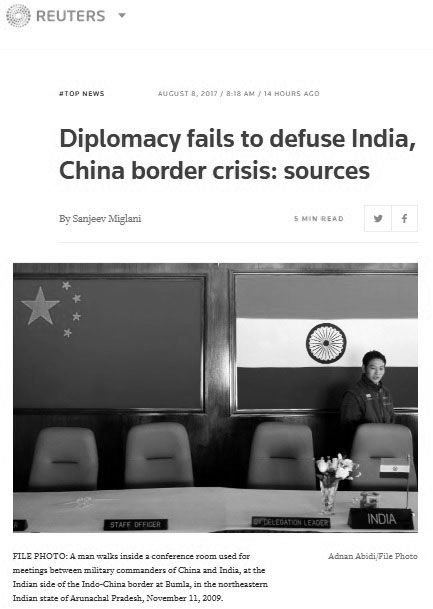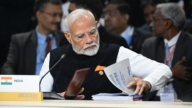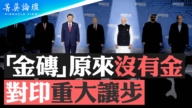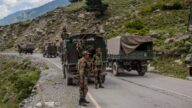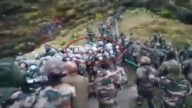【新唐人北京時間2017年08月10日訊】中印邊境對峙已經持續一個多月,仍不見緩和。中共近日集中火力「聲討」印度,逼迫印方「無條件撤軍」。但外媒消息稱,中方曾一度答應後退100米換取印度撤軍,但相關消息在大陸網絡被刪。
8月8日,路透社報導,同印度總理莫迪辦公室關係密切的一名消息人士透露,印度要求中共軍隊從洞朗對峙前線後退250米,但中共沒有回應。
報導稱,在一場避開公眾視線的秘密談判中,中方人員一度表示同意後退100米,但需要請求最高層批准。不過,之後中方就沒有了迴音,印度等來的是北京一連串的警告。
另一個消息來源也表示,目前局勢沒有任何進展,雙方陷入僵局。他擔心對峙可能會拖延到下月在北京舉行的金磚首腦會議。
路透社有關「中方曾同意退兵100米」的消息,很快在大陸網絡上遭封禁,原因可能是與中共官方一再宣稱的「印度無條件撤兵」立場相悖。(相關報導:央視主播轉發共軍洞朗後撤100米 微博被秒刪)
中共近日對印度態度空前強硬,官媒8月7日甚至放出風聲稱,中共可能在兩週內清場。
《美國之音》引述香港軍事評論員馬鼎盛的分析認為,所謂「清場」並不一定意味着開火,有可能只是用蠻力把印度軍人強行驅離。因為一旦動武導致衝突升級,無論是北京還是新德里都不好收場。
路透社引述新德里中國問題學者 Srikanth Kondapalli 的分析稱,雙方發生軍事衝突的幾率很低,沒有人認為習近平會在中共十九大之前開戰。
8月7日,大陸網絡一度傳出中資企業從印度撤離的消息。中共官媒很快出面「闢謠」稱,大規模撤僑並不存在,更不應被理解為是「備戰行為」。隨後,某的士司機被指「散布謠言」,遭警方拘留。
《印度時報》8月7日報導,在對峙地點中印雙方各有約300—350人。在其背後,印度在甘托克、賓那古裡和卡林朋各部署一個山地師,每個師有約1萬兵力。而中方在後方駐軍分三個層次,只有1,500兵力。
印度軍方稱,雙方近兩個月來從未向邊境增兵。
外界分析,中印雙方看似劍拔弩張,實際上都不想爆發戰爭,其「交戰戰場」僅限於媒體和外交場合。
以下為路透社報導原文:
NEW DELHI (Reuters) – India’s diplomatic efforts to end a seven-week military standoff with China have hit a roadblock, people briefed on the talks said, prompting Chinese state-run media to trumpet rhetoric of “unavoidable countermeasures" on the unmarked border.
China has insisted that India unilaterally withdraw its troops from the remote Doklam plateau claimed by both Beijing and Indian ally Bhutan.
(For a graphic on China-India border dispute click tmsnrt.rs/2wnxWuV)
But China did not respond to India’s suggestion in the talks that it move its troops back 250 meters (820 ft) in return, said one source with close ties to Prime Minister Narendra Modi’s government.
In the low-key diplomatic maneuvers that took place outside the public eye, the Chinese countered with an offer to move back 100 meters (328 ft), so long as they received clearance from top government officials.
But there has been no comeback since, except for China’s mounting warnings of an escalation in the region, which it calls Donglang.
“It is a logjam, there is no movement at all now," said a second source with knowledge of the talks.
In Beijing, China’s Foreign Ministry said the country would never give up any territory.
“Under no circumstances will China make its own territorial sovereignty a term of exchange," it said in a statement sent to Reuters when asked about the talks, reiterating that India had to unconditionally withdraw its forces.
Indian troops went into Doklam in mid-June to stop a Chinese construction crew from extending a road India’s military says will bring China’s army too close for comfort in the northeast.
Their faceoff since, military experts say, is the most serious since going toe-to-toe in the 1980s, with thousands of soldiers each, elsewhere along the 3,500-km (2,175-mile) border.
China has held off going to war in the hope New Delhi would see reason, the state-run Global Times, which has kept up a barrage of hostile commentary, said on Tuesday.
“If the Narendra Modi government continues ignoring the warning coming from a situation spiraling out of control, countermeasures from China will be unavoidable," it said.
The border crisis caps a year of souring diplomatic ties between the Asian giants, even though trade between the fast growing economies is rising rapidly.
India has grown concerned at China’s ties to its arch rival Pakistan, viewing their trade corridor across Kashmir as an infringement of its claim to the whole of the region.
Modi refused to join President Xi Jinping’s signature Belt and Road initiative to knit together Asia and beyond, making India the lone country to boycott a summit in May.
China has warned New Delhi not to be drawn into a Western military alliance led by the United States and including Japan. Modi has sought closer ties with both.
“There will be no happy ending for this confrontation," Indian foreign policy expert C. Raja Mohan wrote in the Indian Express newspaper, adding that India was unlikely to give in.
The second source said the worry was the standoff could drag on into a summit of BRICs nations China is hosting next month.
LIVE MANEUVERS
Indian military officials say there is no troop buildup on either side, nearly two months into a standoff that involved about 300 soldiers just 100 meters (328 ft) apart on a plateau 3,000 m (10,000 ft) above sea level.
China has accused India of massing troops, however, and state media have warned against a fate worse than its defeat in a brief border war in 1962.
“We will keep engaging with China to resolve the dispute. War cannot solve problems," Indian Foreign Minister Sushma Swaraj told parliament, sticking to a conciliatory stance.
Still, both have flexed their muscles.
Last month, China held live-fire drills on the Qinghai-Tibet Plateau near the site of the standoff, state media said.
India’s army ran low-key exercises in the Ladakh sector of the western Himalayas, where previous disputes have flared, though it is thousands of miles distant from Doklam.
“The chance of a conflict is low, nobody is expecting Xi Jinping to go to war before the Communist Party’s congress," said Srikanth Kondapalli, a China specialist at Jawaharlal Nehru University in New Delhi, referring to an Oct-Nov meeting expected to confirm a second five-year term as party general secretary for the Chinese leader.
(記者桓宇報導/責任編輯:唐睿)



